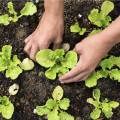Cauliflower
Cauliflower

Cauliflower is grown much like broccoli and cabbage, but plants are less tolerant of heat and cold. Start from transplants in spring. Direct seed or use transplants in fall. Select early maturing varieties to avoid late spring heat and late fall cold. Cauliflower plants are more sensitive to spring freezes than broccoli or cabbage.
Cauliflower plants must be kept growing vigorously from germination through harvest. Any interruption in growth caused by drought, heat, or cold can cause the edible head to fail to develop (button). Use a starter solution (page 9) when setting plants in the garden.
Some of the new cauliflower hybrids are self-blanching (leaves fold over developing head), eliminating the need for tying outer leaves to ensure a white head. With nonself-blanching types, tie the large outer leaves loosely together over the center of the plant when the small head is 2 to 3 inches in diameter. The head should be ready to harvest 7 to 12 days after tying the leaves. Cut the head before it develops a coarse, ricey appearance. Cauliflower plants make only a single head. Downy mildew can be a serious disease problem. Aphids, cabbage loopers, and imported cabbage moths are major insect pests.
Varieties
- Majestic—hybrid; earlier than Snow Crown; heads 7 inches across; 66 days.
- Snow Crown—hybrid; early Snowball type; white heads up to 8 inches across; 68 days; AAS 1975.
- Snow King—hybrid; extra early; withstands heat; ideal for fall; 60 days; AAS 1969.
Publications
News
With nearly a decade of horticultural production experience, the new vegetable specialist with the Mississippi State University Extension Service plans to serve growers statewide.
Spring is right around the corner, and you probably are getting an itch to start setting out plants in your landscape and garden. If you’re new to gardening, you’ll need to know what plant hardiness zone you’re in.
RAYMOND, Miss. -- Many of the practices associated with sustainability, such as recycling, can be extended into the garden. Composting is a way to help reduce organic waste that goes to the landfill and helps feed gardens. These organic materials, which include grass clippings, leaves and other yard wastes, account for about 30% of trash that goes to the landfill.



